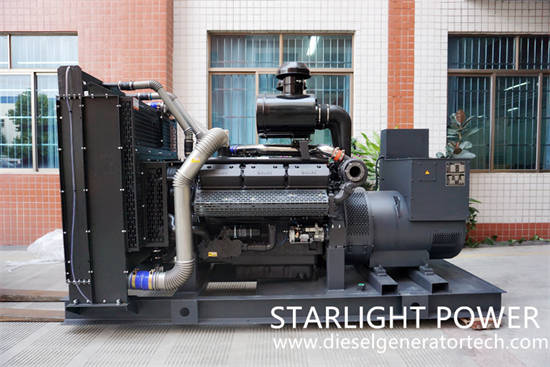Fault feature 1: The diesel generator cannot reach the specified power.
Possible causes:
(1) The bearing is worn.
(2) The compressor impeller and its volute flow passage are contaminated.
(3) Too much carbon is deposited at the back of turbine and compressor impeller and at the sealing ring.
Troubleshooting:
(1) Have professional maintenance personnel replace the bearing.
(2) Have them cleaned by professional maintenance personnel.
Fault feature 2: The exhaust smoke color of the diesel generator is abnormal, and the exhaust pipe emits black smoke (insufficient air intake).
Possible causes:
(1) Some flow passages of compressor are contaminated.
(2) The compressor leaks.
Troubleshooting:
(1) Have them cleaned by professional maintenance personnel.
(2) Ask professional maintenance personnel to check the sealing condition and eliminate air leakage.

Fault feature 3: Blue smoke from exhaust.
Possible causes:
(1) The elastic sealing ring loses elasticity or is excessively worn.
(2) The oil return passage of the intermediate casing is blocked or the pipeline is deformed.
Troubleshooting:
(1) Have professional maintenance personnel replace the elastic sealing ring.
(2) Have professional maintenance personnel clean and repair the deformation.
Fault characteristics: 4: Abnormal sound and vibration.
Possible causes:
(1) The compressor surges and the supercharger vibrates with large amplitude (serious contamination of compressor channel, intake pipe and turbine outlet channel is one of the reasons for surge).
(2) Improper assembly (turbine and compressor rotors lose dynamic balance or rotating parts collide with fixed parts).
(3) The blades of the turbine wheel or compressor wheel are damaged by incoming foreign materials.
(4) The deformation of the turbine casing causes friction.
(5) There are foreign matters in the passage of the vaneless volute, which are found in the diesel engine. Abnormal sound can be heard when idling.
Troubleshooting:
(1) Have them cleaned by professional maintenance personnel.
(2) Have professional maintenance personnel dismantle, inspect and repair.
(3) Let professional maintenance personnel check and repair, and replace the supercharger if necessary.
(4) Have the professional maintenance personnel find out the cause of the deformation and eliminate it. If necessary, replace the supercharger.
(5) Have the professional maintenance personnel dismantle and check the channel section, and check the diesel engine intake and exhaust system at the same time.
Fault feature 5: The turbine press rotor cannot rotate or is not flexible.
Possible cause: Serious carbon deposition at the back of turbine, compressor and elastic seal ring seat.
Troubleshooting: ask professional maintenance personnel to clean and check the diesel engine for poor combustion and oil leakage.
Fault characteristics: 6: Bearing burning and rotor rubbing.
Possible causes:
(1) The lubricating oil is too dirty, the oil pressure is too low or the oil path is blocked.
(2) The inlet oil temperature is too high.
(3) The dynamic balance of turbine and compressor rotor is damaged or improperly assembled.
(4) The exhaust temperature is too high and the supercharger speed is too high.
(5) The turbine casing is deformed.
Troubleshooting:
(1) Check the lubrication system and clean the filter.
(2) Find out the cause of oil temperature reduction.
(3) Have professional maintenance personnel dismantle, check and recheck the balance; Replace the supercharger if necessary.
(4) Check the diesel engine and exhaust pipe for serious air leakage, deformation, blockage, etc., repair and clean them.
(5) Find out the cause of deformation and eliminate it. Replace the supercharger if necessary.
Fault feature 7: Speed drop, intake pressure drop, air leakage or abnormal sound, etc.
Possible causes:
(1) The supercharger bearing is worn and the rotor is rubbing.
(2) The air inlet pipe of the compressor is contaminated, blocked or leaking.
Troubleshooting:
(1) Have the supercharger repaired by professional maintenance personnel and replaced if necessary.
(2) Have professional maintenance personnel repair and clean the compressor casing, wipe the impeller and clean the air inlet pipeline; Tighten the joint nuts, clamps, etc.
Jiangsu Starlight Electricity Equipments Co.,Ltd. has a young and professional technical backbone team, with an average working age of more than 10 years in the generator unit industry. There are 64 sales and service departments throughout the country to provide users with a one-stop service of machine room design, equipment supply, commissioning and maintenance at any time. No matter when and where, a well-trained service team will provide you with comprehensive and considerate protection. For more details, please contact us with sales@dieselgeneratortech.com.
Comments
Post a Comment